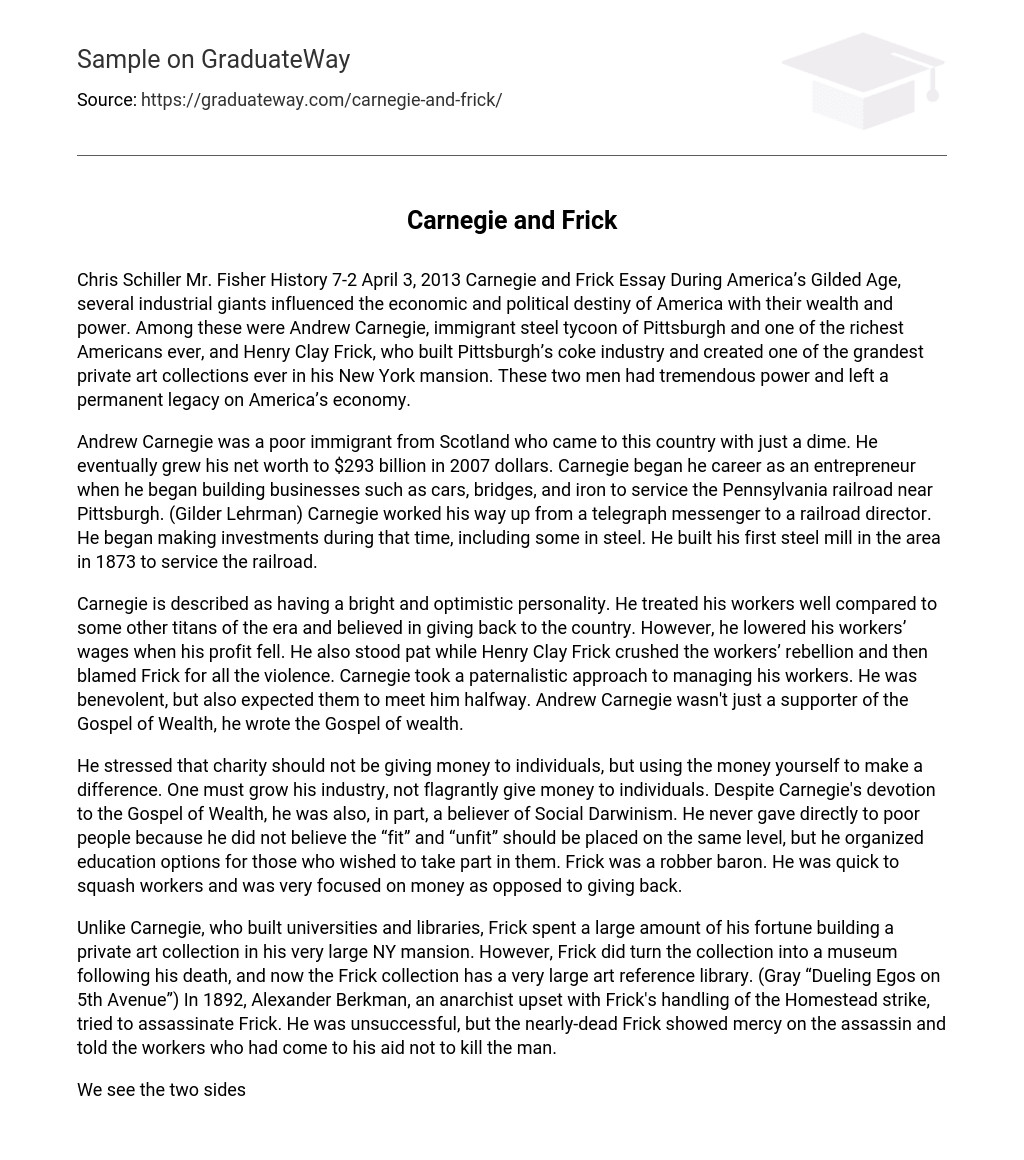During America’s Gilded Age, several industrial giants influenced the economic and political destiny of America with their wealth and power. Among these were Andrew Carnegie, immigrant steel tycoon of Pittsburgh and one of the richest Americans ever, and Henry Clay Frick, who built Pittsburgh’s coke industry and created one of the grandest private art collections ever in his New York mansion. These two men had tremendous power and left a permanent legacy on America’s economy.
Andrew Carnegie was a poor immigrant from Scotland who came to this country with just a dime. He eventually grew his net worth to $293 billion in 2007 dollars. Carnegie began he career as an entrepreneur when he began building businesses such as cars, bridges, and iron to service the Pennsylvania railroad near Pittsburgh. (Gilder Lehrman) Carnegie worked his way up from a telegraph messenger to a railroad director. He began making investments during that time, including some in steel. He built his first steel mill in the area in 1873 to service the railroad.
Carnegie is described as having a bright and optimistic personality. He treated his workers well compared to some other titans of the era and believed in giving back to the country. However, he lowered his workers’ wages when his profit fell. He also stood pat while Henry Clay Frick crushed the workers’ rebellion and then blamed Frick for all the violence. Carnegie took a paternalistic approach to managing his workers. He was benevolent, but also expected them to meet him halfway. Andrew Carnegie wasn’t just a supporter of the Gospel of Wealth, he wrote the Gospel of wealth.
He stressed that charity should not be giving money to individuals, but using the money yourself to make a difference. One must grow his industry, not flagrantly give money to individuals. Despite Carnegie’s devotion to the Gospel of Wealth, he was also, in part, a believer of Social Darwinism. He never gave directly to poor people because he did not believe the “fit” and “unfit” should be placed on the same level, but he organized education options for those who wished to take part in them. Frick was a robber baron. He was quick to squash workers and was very focused on money as opposed to giving back.
Unlike Carnegie, who built universities and libraries, Frick spent a large amount of his fortune building a private art collection in his very large NY mansion. However, Frick did turn the collection into a museum following his death, and now the Frick collection has a very large art reference library. (Gray “Dueling Egos on 5th Avenue”) In 1892, Alexander Berkman, an anarchist upset with Frick’s handling of the Homestead strike, tried to assassinate Frick. He was unsuccessful, but the nearly-dead Frick showed mercy on the assassin and told the workers who had come to his aid not to kill the man.
We see the two sides of Frick’s personality as he is both ruthless in squashing rebellions and merciful to a potential assassin. (Think quest Library) Frick was a believer of Social Darwinism. When the Homestead Strike began, he simply hired three hundred Pinkerton detectives to squash the workers without breaking a sweat. WHILE BLOOD FLOWED, FRICK SMOKED read a New York World headline. He believed that he was meant to be at this position and those below him were meant to be there. Frick and Carnegie were business partners for much of their careers, but not always happy ones.
When the dying Carnegie, after twenty years away from Frick, asked to see him once more, Frick answered, “I’ll meet him in Hell. ” (Standiford 13) Both Carnegie and Frick built New York mansions, Frick’s a mile south of Carnegie’s and built later. Frick built it in 1914, promising it would “make Carnegie’s place look like a mine shack. ” The rivalry began when Frick’s coke company was swallowed up by Carnegie Steel and Frick began to run the company for Carnegie. Frick even got into a dispute with Carnegie over who was in charge of the holdings of Carnegie Steel.
Despite their differences, Carnegie and Frick benefited from each other and without their partnership, neither would have become as successful as they were. Andrew Carnegie and Henry Clay Frick were two very different men. One was focused on giving back; the other more on gaining money. But their differences besides, these two men formed one of the most powerful partnerships ever. They ruled the steel industry and grew their fortunes exponentially.





